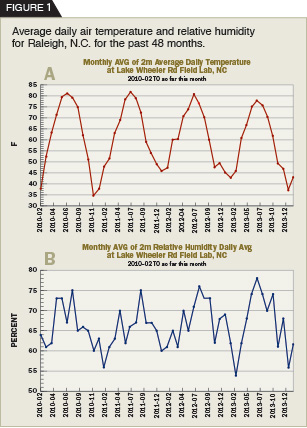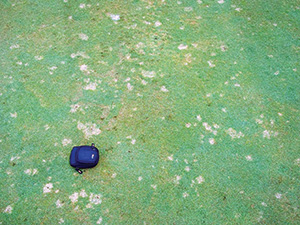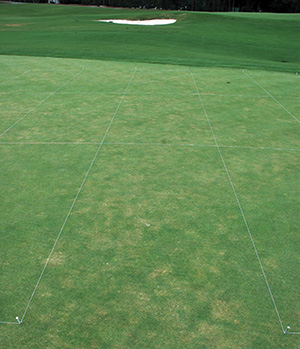Factors affecting fungicide performance Part 2 of 3: Disease pressure and fungicide resistance
Editor’s note: This is the second of three articles by Dr. Kerns on disease management and control.
After selecting the appropriate fungicide to control the target disease, the next thing to consider is disease pressure and fungicide resistance. This article will discuss how disease pressure influences rate selection and application intervals. It will also dive into a discussion of fungicide resistance prevention and management.
The disease triangle
Disease is a rare event in nature; it takes three factors to come together in time, in order for disease to develop: a susceptible host, a virulent pathogen and a conducive environment.
These three factors comprise the disease triangle. The severity of the disease is governed by the length of each side of the triangle. For example, planting a more disease-resistant turfgrass species or cultivar can shorten one side of the triangle and thereby reduce the amount of disease. Many new cultivars have some disease resistance, but in order to take advantage of this, a significant renovation is typically required. When a renovation is planned, it is important to consider these new cultivars that have resistance to dollar spot or other diseases, as they will likely save on fungicide applications.
Unfortunately, our turf pathogens are ubiquitous organisms which wait for our turf plants to succumb to stress and then they attack. Although it is difficult to eliminate pathogens from turf systems permanently, understanding the biology of the pathogens can aid in designing fungicide programs that maximize efficacy and efficiency. For example, many turf pathologists have revitalized efforts to research biology and epidemiology of dollar spot. Some are working on the population structure and dynamics of the pathogen to develop a more appropriate classification for the fungus and to understand how genetic diversity may lead to fungicide resistance. Others are working on developing a forecasting model for the disease.
University studies
Dr. Damon Smith and I developed a fairly robust forecasting model while I was at the University of Wisconsin-Madison and he was at Oklahoma State. The model worked well in both locations and then we expanded our testing to include the University of Tennessee (Dr. Brandon Horvath), Penn State (Dr. John Kaminski), and Mississippi State (Dr. Maria Tomaso-Peterson). Fortunately, the model has also performed well in these additional locations.
 Focusing on epidemiology also showed us that the dollar spot fungus could cause disease at temperatures ranging from 59 to 95 degrees F as long as relative humidity remains above 70 percent for five consecutive days. At each location we were able to save, on average, a single fungicide application per year when using the dollar spot forecasting model. If applied to a large area like a fairway, the savings could be significant. Currently we are working on publishing this work in a peer-reviewed scientific journal and we hope to deploy the model later this year for general use.
Focusing on epidemiology also showed us that the dollar spot fungus could cause disease at temperatures ranging from 59 to 95 degrees F as long as relative humidity remains above 70 percent for five consecutive days. At each location we were able to save, on average, a single fungicide application per year when using the dollar spot forecasting model. If applied to a large area like a fairway, the savings could be significant. Currently we are working on publishing this work in a peer-reviewed scientific journal and we hope to deploy the model later this year for general use.
The idea from this work is that the biology of these pathogens drives disease severity. Therefore, having a basic working knowledge of when diseases develop will help you to develop more effective fungicide programs. Although scheduling fungicide applications using a calendar can be effective, we have seen many failures using this approach. Fungicide purchases are made in the off-season, but those were likely made on data collected from many seasons at your location.
I advocate looking at historical weather data to schedule fungicide applications for the upcoming season because fungi respond to environmental stimuli. For example, Figure 1 shows average daily air temperature and relative humidity for Raleigh, N.C. for the past 48 months. Notice that temperatures are typically conducive for dollar spot development in early April, but our relative humidity does not consistently eclipse 70 percent until May. Based on our work, dollar spot will not develop unless we have four to five consecutive days of 70 percent relative humidity or higher.
I am not saying dollar spot will never develop in April because each year is different. However, I would advocate that your first fungicide application in April for preventative fairy ring or take-all patch would keep dollar spot suppressed.
Planning ahead
Many turf pathologists have observed long residual dollar spot control with fungicide applications applied well before disease development. When applying fungicides preventatively, turfgrass managers have more choice with their application strategy.
Once a disease has developed, usually the only effective chemical management strategy is high rates on short intervals. Not only are you fighting very active pathogens, but you are also fighting fungicide depletion. This will be covered more in the next article.
Pythium blight and summer patch are good examples of fighting an uphill battle with curative chemical management. Pythium blight develops when nighttime temperatures eclipse 72 degrees F and relative humidity is high. Scheduling preventative fungicide applications even a few days prior to this weather allows for lower rates and longer re-application intervals when compared to managing the disease after it has developed.
Summer patch is another difficult disease, as it is frequently lumped in with take-all patch because it only infects within a specific temperature range. However, in creeping bentgrass in the transition zone, it seems like the fungus in summer patch continues to infect and colonize the host throughout the summer months. Those who have struggled with summer patch should schedule the first application when soil temperatures at a two-inch depth reach 65 degrees F. It is wise to re-apply products at least monthly throughout the summer to ensure protection.
Dealing with resistance
With some diseases, once the damage is done, fungicides are typically not effective. This is the case with Pythium root dysfunction and take-all patch.
These organisms infect and colonize roots at specific soil temperatures, 55 to 65 degrees F for take-all patch and 55 to 75 degrees F for Pythium root dysfunction, and beyond these soil temperatures the organisms are not active. Once a fungus or a Pythium species stops growing or enters survival mode, fungicides are essentially not effective. This is why so many turf extension specialists harp on preventative fungicide applications to ensure efficient uptake of the fungicides by the target organism.
Curative control is possible with many diseases. Yet due to optimal conditions for the pathogen or inactivity, high rates are needed and failures should be expected. Constantly exposing the pathogen population to high rates of a fungicide may add undue selection pressure on the population, which in turn may lead to resistance.
Fungicide resistance is inherent in many turfgrass pathogen populations due to the ubiquitous nature and size of the population. Initially a population has a certain number of individuals possessing resistance or tolerance to a specific class of fungicides. Repeated applications of the same class of fungicides over time leads to selection of the resistant or tolerant individuals and once that population takes over, we see loss of control in the field.
Thinking about dollar spot and anthracnose, these diseases are omnipresent throughout the U.S. Turf managers frequently spray fungicides for dollar spot and those applications are altering the population dynamics of the anthracnose fungus population and vice versa. We typically only think in a single dimension when applying fungicides. In other words, I have boscalid, iprodione, propiconazole, chlorothalonil, propiconazole and iprodione scheduled for dollar spot control and these chemicals are only affecting the dollar spot population. Yet, all the other potential pathogens are likely present in that system. The fungicide program as a whole should be examined when thinking about fungicide resistance.
The tank-mixing or rotating question
Since we have many more single-site fungicides (medium to high risk for resistance) when compared to multi-site fungicides (low risk for resistance), the question arises: is it better to tank-mix or rotate?
Our current understanding is that both strategies can extend the life of our products and delay control failures. Concerning diseases with medium to high risk for resistance, I would advocate tank mixing and rotating. Right now it is very expensive to bring new chemicals to the market and with the saturation of the fungicide market, companies need a slam dunk before they will register anything new in turf. Although we are seeing many new products coming in the next few years, it is important to maximize the life of these great products for as long as possible.
When working with diseases such as dollar spot and anthracnose, rotate and tank-mix fungicides. This is relatively easy to do. Look at the top of the fungicide label for the FRAC number and ensure you are throwing as many different numbers at these diseases as possible.
Many turf managers are already dealing with resistance at their golf course. In many cases, fungicide classes such as the benzimidazoles, dicarboximides and DMIs may be useless or have extremely short residuals. Preventative applications of multi-site fungicides such as chlorothalonil and fluazinam are required to ensure good disease management. However, an area that we still do not clearly understand is the fitness cost to the pathogen when the population becomes resistant.
What did the fungus give up in order to circumvent the consistent fungicide application? We know from grape pathology that there is a documented fitness penalty when a resistance develops to the dicarboximide family, which means the population will likely revert to the original non-resistant state. Many labs are working to understand the biological consequences when fungi develop resistance, but we are not quite there yet. The bottom line is that managing fungicide resistance should follow the same strategy as preventing fungicide resistance. I advise superintendents to rotate and tank-mix products when managing fungicide resistance.
Utilizing resources
The current suite of fungicides is quite awesome with respect to efficacy, but selecting the appropriate product, rate and timing still requires knowledge of the target pathogen. It is important for turfgrass managers to remain current on research surrounding turf diseases. Attend meetings, the GIS and regional shows to catch up on the current knowledge on diseases. Having good resource material in the office is helpful.
Another essential resource, in addition to the ones I mentioned in the previous article, is the “Compendium of Turfgrass Diseases” published by APS Press. It has a beautiful collection of images and succinct descriptions of turf diseases, including conditions that favor disease development. Of course, your local turfgrass extension specialist would be willing to help with building a successful fungicide program as well. However even with all the knowledge they possess, they can only be helpful if the turf managers are completely open and honest with them regarding their situation and issues.
Disease pressure and fungicide resistance enter the thought process when purchasing chemicals and developing a solid disease management program, but what happens to the fungicide after they are applied? The next article will cover that topic!
Jim Kerns, Ph.D. is an assistant professor and extension specialist in turfgrass pathology in the Department of Plant Pathology at North Carolina State University. For more information, Dr. Kerns can be reached at jpkerns@ncsu.edu
References
Latin, R. 2011. A Practical Guide to Turfgrass Fungicides. APS Press. St. Paul, MN.
Smiley, R.H., P.H. Dernoeden, and B.B. Clarke. 2005. Compendium of Turfgrass Diseases. 3rd Ed. APS Press. St. Paul, MN.










